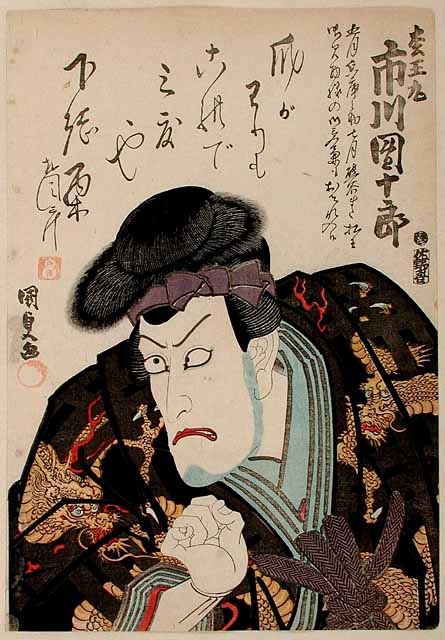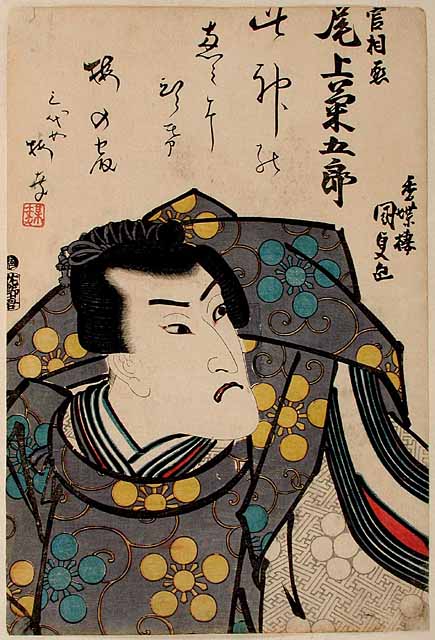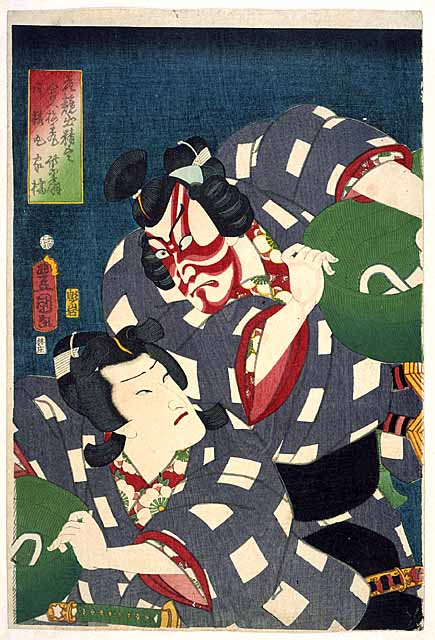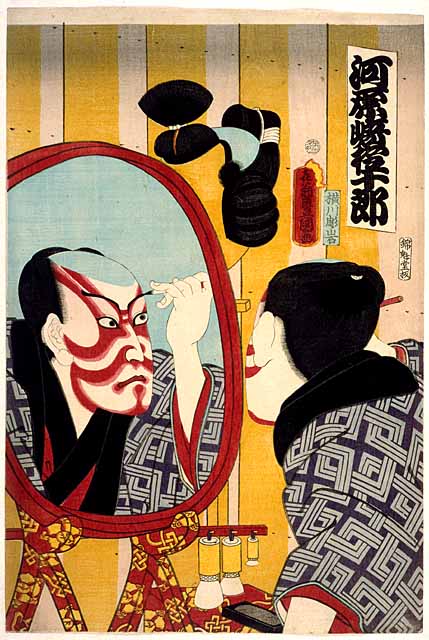
Ichikawa Danjuro VII as Matsuomaru in Sugawara denju tenarai kagami (Sugawara and the Secrets of Calligraphy) performed at the Kawarazaki Theatre in 09.1831
Private collection
For a more detailed description
Loan 148

Sawamura Gennosuke II as Kan Shojo in Sugawara denju tenarai kagami (Sugawara and the secrets of calligraphy) performed at the Kawarazaki Theatre in 09/1831
Private collection
Loan 171

Onoe Kikugoro III as Kan Shojo in Sugawara denju tenarai kagami (Sugawara and the secrets of calligraphy) performed at the Nakamura Theatre in 11/1835
Private collection
Loan 220

Kawarazaki Shisen (Kawarazaki Gonjuro I as Umeo-maru and Ichimura Kakitsu (Ichimura Uzaemon XIII) as Sakura-maru
Kunisada 64
Kawarazaki Shisen (Kawarazaki Gonjuro I) as Umeo-maru and Ichimura Kakitsu (Ichimura Uzaemon XIII) as Sakura-maru in Sugawara denju tenarai kagami (Sugawara and the secrets of calligraphy) performed at the Ichimura theatre from 17/10/1861
Given by the Friends of the Fitzwilliam with the aid of the MGC Purchase Grant Fund and the National Art Collections Fund.
From the set entitled ‘Series Comparing the Diligence of Young Flowers’ (Hana-kurabe shussei-zukushi), published 11/1861. Kunisada designed several prints in connection with this performance, three of which are included in this exhibition in this case.
This print depicts two of the triplets in the scene called Kuruma Biki (Pulling the Carriage Apart) in which they confront their triplet brother Matsuo-maru who serves their enemy Shihei.
They each wear a thick padded dotera kimono with a pattern of large purple and white squares (soshigoshi). They hold the green wicker hats (amigasa) that they have just removed, revealing their faces. Sakuramaru is the more elegant figure with subtle eye make-up known as mukimi (‘trough-shell shadows’) and divided forelock wig called mae jasen (‘front-facing tea whisk’); his more gentle role is traditionally played in a slightly effeminate manner (wakashugata).
In contrast Umeo-maru is one of the prime examples of the aragoto (‘rough-stuff’) style of acting, with appropriately fierce red make-up with extra shadow lines (nihon suji guma), and extravagant wig with high pom-pom and spoke-like projections on either side, known as the kuruma bin (carriage sidelocks). For this scene he wore muscular body ‘make-up’, visible on his hands and arms, which was actually dyed onto white silk skin-garments. Aragoto roles were particularly associated with the Danjuro lineage of actors.
Collections Record: P.86-1999

Kawarazaki Gonjuro I (Danjuro IX) backstage applying make-up for the role of Umeo-maru in Sugawara denju tenarai kagami (Sugawara and the secrets of calligraphy) performed at the Ichimura theatre from 17/10/1861
Given by the Friends of the Fitzwilliam with the aid of the MGC Purchase Grant Fund and the National Art Collections Fund
Published in 12/1861. Kunisada designed several prints in connection with this performance, three of which are displayed in this case. Umeo-maru is one of the prime examples of the aragoto or ‘rough-stuff’ style of kabuki role, with appropriately fierce red make-up (nipponsujigama) applied on a white base, and an extravagant wig (seen on the wig-stand) with high pom-pom and spoke-like projections on either side, known as the kuruma bin (carriage sidelocks). Gonjuro I can be seen as Umeo-maru in another print in this exhibition.
Collections Record: P.87-1999

Nakamura Shikan IV as the guard Matsuo-maru in Sugawara denju tenarai kagami (Sugawara and the secrets of calligraphy) performed at the Ichimura theatre from 17/10/1861
Kunisada 62
Given by the Friends of the Fitzwilliam with the aid of the MGC Purchase Grant Fund and the National Art Collections Fund.
From the series Tosei jihitsu kagami (Mirror of Contemporary Autographs), published 12/1861, with portraits by Kunisada juxtaposed against landscapes or still-lifes. This print, published in 11/1861, was one of several designed by Kunisada in connection with the same production, three of which are included in this exhibition. Here the villain Matsuo-maru appears in the scene called Kuruma biki (Pulling the carriage apart), which the Kabuki version had added to the original puppet play. The stage setting is conjured up in the hokku poem, signed in imitation of the actor’s own calligraphy, which appears to the left on the tanzaku (long poem card) decorated with pine needle and cone motifs:
- Kamigaki ya Within the shrine fence
- yo no ki wa nakute none of the other trees
- matsu no hana is as flowery as the pine.
The poem puns on the word matsu, ‘pine’, which forms part of the name of Matsu o-maru. The scene is set at Yoshida Shrine in Kyoto, with stage props usually including a torii gate, a low red kamigaki shrine fence (as mentioned in the poem), and cherry (sakura) and plum (ume) trees in reference to the names of Matsuo-maru’s triplet brothers, Sakura-maru and Ume o-maru. By comparing the trees, the poem also suggests that the role of Matsuomaru is more prominent than the others in this play.
Collections Record: P.85-1999

Ichikawa Danjuro VII as Kan Shojo (top) and Segawa Kikunojo V as Umeomaru (bottom)
Ichikawa Danjuro VII as Kan Shojo (top) and Segawa Kikunojo V as Umeomaru (bottom) in Sugawara denju tenarai kagami (Sugawara and the secrets of calligraphy) performed at the Kawarazaki theatre in 09/1832
Given to the Fitzwilliam Museum by E. Evelyn Barron in 1937
Spring kyoka surimono commemorating the performance in the ninth month of 1832 at the Kawarazaki Theatre in Edo of Sugawara denju tenarai kagami (Sugawara and the secrets of calligraphy). The print shows the Tempaizan scene at Mount Tempai on Kyushu, where the exiled Sugawara, known as Kan Shojo, learns in a dream that his favourite plum tree from the garden in his home in Sada village has been moved to nearby Anraku Temple so that he may enjoy its blossoms. When he goes there he encounters one of his retainers, Umeomaru, involved in a duel. He breaks off a branch from the tree and magically decapitates Umeomaru’s opponent. He then learns from Umeomaru that his loss of position at court and subsequent exile are due to the machinations of his rival Shihei (Fujiwara Tokihira). Flying into a rage he turns into the Thunder god, raises a storm and, to the accompaniment of lightning, flies off to the capital (Kyoto) to muster support in preventing Shihei from gaining power.
The print conflates the scene of the duel with Kan Shojo’s transformation into the Thunder God. The poems include images of blossoms of plum (umeo), and Umeomaru’s jacket is decorated with the flower. Kan Shojo was one of Danjuro’s most celebrated roles. Almost twenty years earlier Kunisada designed a print of him in the role with the branch of plum blossom clenched between his teeth, in a set of ‘Great Performances’.
Collections Record: P.512-1937



